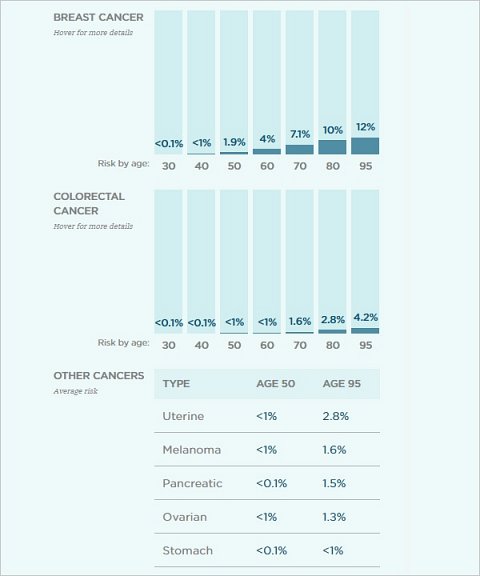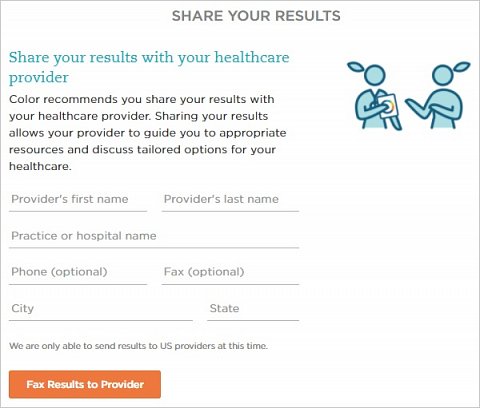-
Color Extended
review on April 27, 2017
by Ellen Hinkley

At a Glance
Summary
I’m really glad I took the Color Genomics test. The benefits, but also the limitations of the test were exceptionally well explained at several points during the process and I left feeling reassured about my cancer risk, but not under the illusion I was somehow immune due to my genetics.
The report itself didn’t include as much information as I was expecting, and I would have liked to see the specific genetic variants identified in the genes analyzed. That said, the main point in taking the test was to find out whether any of these variants may increase my risk of developing cancer and this was communicated clearly and sensitively. The experience also made me feel better informed about cancer and the link between genetics and disease in general.
Full Review
Color Genomics is a company that sells genetic predisposition tests, specifically focused on hereditary cancer. Founders Othman Laraki and Elad Gil, used their experience gained at Twitter, Google, and Microsoft as well as Gil’s doctorate in cancer biology, to introduce their genetic cancer screening test in 2015. The test has since evolved from the analysis of 19 genes to assess the risk of developing ovarian and breast cancer, to analyzing 30 genes for mutations that increase the risk of developing eight different types of cancer. The company’s vision is to reduce the cost of genetic cancer screening and has recently secured $45,000,000 in funding to help it move towards this goal.
Product Expectations
There was a lot of information about the Color test on the website. I read that the test would analyses my DNA to assess my hereditary (or genetic) risk of developing 8 different types of cancer. There was a list and a table of the 30 genes that would be screened for mutations associated with an increased risk. These included BRCA1 and BRCA2, which I’d already heard about when the actress Angelina Jolie took a similar test a few years ago.
There was a ‘How it works’ section that explained, step-by-step and with diagrams, what to expect from the process of taking the test. I was reassured by the fact that it was physician-ordered and that the purchase of the test would include a consultation with a genetic counselor as well as continued updates as more research was published
I was interested to see that there were separate ‘Why get tested?’ sections for men and women. Both sections had lots of information and diagrams which explained the science behind the test, but with differing emphasis on the cancers that most affected each gender.
I was really impressed by how well Color explained the complexity of cancer. They were upfront about the fact that the understanding of it is still limited and that the majority of cases seem to happen at random rather than as a result of the types of inherited mutations identified in their test. Each section gave me the option to read more, and was referenced. As well as increasing my trust in the company, I left this section feeling much better informed and was convinced I’d made the right decision in choosing to take the test.
The terms and conditions and privacy policy didn’t contain anything that struck me as unusual, though I was pleased to see that Color would not analyses the DNA of anyone under 18. This was also made clear at several points before purchasing
Ordering experience
The ordering experience was really straightforward. The purchase page included several images of the kit itself as well as the components included in it. The was also video showing exactly how to collect my sample once I’d received my kit. I had the option to order the kit for myself or someone else. I also had to choose whether to have my own physician order the test or have “an independent physician from and external network” approve it at no extra cost.
I had to pay $9.95 for shipping and handling, which seemed a lot, but the return cost was included. I was also asked if I wanted to donate to Color’s ‘Every Woman Program’.
When activating the test, I was prompted to take a family history survey, and was also shown a video designed to help me prepare for receiving my results. This, in addition to the email communication at each stage and comprehensive explanations of what the test would and wouldn’t tell me, left me feeling both informed and supported throughout the process.
Results Section
I received an email confirming that my sample had reached the lab, with information about what would happen next. I received another three weeks later, informing me that my results were ready.
Results Section: Initial Results
I was more nervous than I thought I’d be. The email informed me that I had the choice to look at my results there and then, or could do so with a genetic counselor. There was a link in the email allowing me to book an appointment.
Another link in the email took me to my account. Before viewing the results there was another page, going over what had previously been mentioned about what the results would and wouldn’t mean. I clicked to indicate that I understood and logged in. I was relieved to see that it was made immediately clear at the top of the page that I had no mutations associated with an increased risk of cancer (shown below).

The statement at the top of my report.
I was really glad that this was so prominent and clear at the top of the page and was pleased to see that there was more to the report below and there was also an option to download it as a PDF.
The button for booking a genetic counseling appointment was highlighted as I started to scroll down. I didn’t feel that I needed one, as no mutations that increased my risk had been identified, but I was glad that this option was still available to me, despite my results.
I chose to look at my results in my web browser instead of downloading them. Underneath the main statement, a paragraph explained that my result meant that none of the 30 genes analyzed contained any of the mutations associated with an increased risk of the eight types of cancer. It went on to reiterate that this didn’t mean my risk of cancer was non-existent, as most mutations that cause cancer aren’t the types that you inherit.
This section also included two graphs showing the ‘Average risk by age among US women’ for breast and colorectal cancer, then a table showing the average risk of developing the other cancers at the ages of 50 and 95 (shown below).

Average risk among US women graphs and table.
It was explained that breast and colorectal cancer were highlighted because they were the most common, which I could see from looking at the percentages. This was interesting and further put into perspective that my result didn’t mean my risk of developing cancer was non-existent.
Results Section: Next steps
The next part of the report was split into several sections. The first was entitled ‘Next Steps’ and went through the screening guidelines for each type of cancer, as well as general guidelines for all types.
I imagine that this would have been tailored to fit with any mutations detected for those people that had tested positive for any, but for me it just listed the government screening recommendations. For some types (eg. breast cancer), there were specific details for specific ages, whereas for others there were no specific guidelines in place, so the general advice of discussing my family history with my healthcare provider was given.
The general recommendations were pretty logical things that I’d heard before, such as avoiding any tobacco and undertaking regular physical activity. However, I felt that it was worth mentioning them in the context of the rest of the recommendations which reminded me that as well as screening to catch any cancer early, there were also practical preventative measures I could take to reduce my risk. Each of these was referenced, with a link to the original guideline document or webpage included.
Below this was a section that gave me the chance to fax my results to my healthcare provider (shown below).

The form designed to help me share my results with my healthcare provider.
I thought this was a strange method of sharing to offer, and decided that if I did want to share my results it would probably be easier to just print out the PDF download. I was also confused as the ‘Fax’ section of the form was marked as optional.
This was followed by an explanation that although my results showed no mutations, other relatives could have mutations that I personally hadn’t inherited, so it was still worth them getting tested themselves. I was also provided with a sample letter that I could use to send to my relatives to tell them about my results. Again, I appreciated that this might have been useful if I had tested positive for any of the mutations, as it provided a very informative way to break such sensitive news to family members.
The section ended with another opportunity to book an appointment with a genetic counselor. This time I clicked to see what the process of scheduling a session would be like. The first stage of the booking process is shown below.

The first stage of the booking process for a genetic counseling appointment.
The calendar showing the available appointments allowed me to pick a date and time convenient for me. I was impressed to see that I’d be able to speak to someone on the phone the same day and that I’d receive a text reminder before the appointment, but decided that I didn’t really need one.
Results Section: Details
The next tab in the results section was entitled ‘Details’, which I expected and hoped would provide information about the genetic variants that had been identified in the genes analyzed. Unfortunately, this only provided the same conclusion that had been given at the top of the report, and the list of genes analyzed. When I clicked to ‘learn more about these genes’ I was taken to the table on the Color website, that I’d seen before I’d taken the test. This was followed by the video I’d seen while waiting to receive my results, and the information about their lab that was also shown on the website.
At the bottom of this section the methods, limitations and disclaimer were included. I found these a bit too complex to understand but appreciated that they had included them, as they provided the opportunity to check their methods and process. Their transparency in terms of these aspects of the test further convinced me of the reliability of my results.
I was slightly disappointed that this section didn’t include more specific details about my results, but it was useful to have all of the relevant information in the same place rather than having to search back through the website/my emails to find each
Results Section: History, Family and Questions
The final part of the report consisted of a ‘History’ section, which summarized my answers to the questionnaire I’d taken previously, a ‘Family’ section, which included the same information as that in the Next Steps section (about sharing my results with my relatives), and a set of frequently asked questions in a ‘Questions’ section. These questions were the most useful part of the last three sections of the report and included useful extra information, such as additional factors (other than inherited mutations) associated with an increased risk of developing cancer. I was surprised to learn that those with Ashkenazi Jewish ancestry are at increased risk of certain cancers, as well as women who give birth to their first child later in life.
Summary
I’m really glad I took the Color Genomics test. The benefits, but also the limitations of the test were exceptionally well explained at several points during the process and I left feeling reassured about my cancer risk, but not under the illusion I was somehow immune due to my genetics.
The report itself didn’t include as much information as I was expecting, and I would have liked to see the specific genetic variants identified in the genes analyzed. That said, the main point in taking the test was to find out whether any of these variants may increase my risk of developing cancer and this was communicated clearly and sensitively. The experience also made me feel better informed about cancer and the link between genetics and disease in general.


